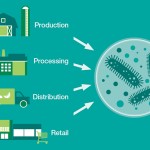Using electronic retail scanner data from grocery stores, IBM Research scientists may have found a faster way to narrow down the potential source food contamination during an outbreak. Researchers from the firm conducted a study in which they were able to show that, using just 10 medical exam reports of foodborne illness, it is possible to pinpoint an investigation to 12 food products of interest in a only a few hours. A typically investigation ranges from weeks to months.
The study, “From Farm to Fork: How Spatial-Temporal Data can Accelerate Foodborne Illness Investigation in a Global Food Supply Chain”, demonstrated a new way to accelerate an outbreak investigation. Researchers reviewed the spatio-temporal data (i.e., geographic location and potential time of consumption) of hundreds of grocery products, and analyzed each product for shelf life, consumption location and the probability that the product harbored a pathogen. This information was then mapped to the known location of outbreaks.
“When there’s an outbreak of foodborne illness, the biggest challenge facing public health officials is the speed at which they can identify the contaminated food source and alert the public,” said Kun Hu, public health research scientist, IBM Research – Almaden in a press release. Rsearchers created a system to devise a list that ranked products based on likelihood of contamination, which would allow health officials to test the top 12 suspected foods. “While traditional methods like interviews and surveys are still necessary, analyzing big data from retail grocery scanners can significantly narrow down the list of contaminants in hours for further lab testing. Our study shows that big data and analytics can profoundly reduce investigation time and human error and have a huge impact on public health,” said Hu.
The researchers point of out their method isn’t a substitute for proven outbreak investigation tools but rather serves as a faster way to identify contaminated product(s). According to the study, researchers assert that their methodology could significantly reduce the costs associated with foodborne illness, outbreaks and recalls. Thus far IBM Research’s approach has been applied to a Norweigan E. coli outbreak in which there were 17 confirmed cases of infection. Public health officials used the method to devise a list of 10 potential contaminants from the grocery scanner data of more than 2600 products. From there, lab analysis traced the contamination source to batch and lot numbers of sausage.
The study was published in the Association for Computing Machinery’s Sigspatial Journal.





